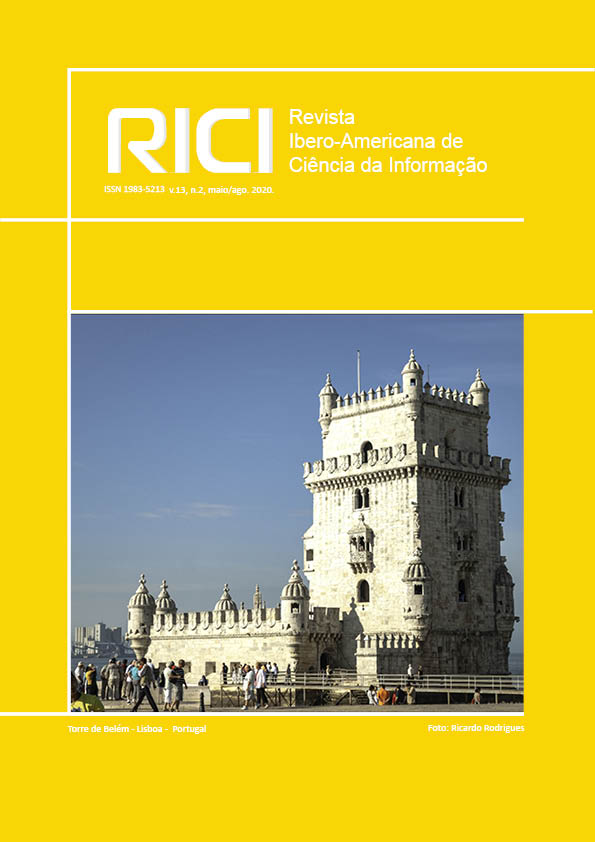Contribution of Nvivo software in the evaluation of a discipline with content in a virtual learning environment
DOI:
https://doi.org/10.26512/rici.v13.n2.2020.31239Keywords:
NVivo. content analysis. qualitative analysis. teaching learning assessment.Abstract
Qualitative data analysis has aroused the interest from researchers, especially in social sciences. At the same time, the volume of this data has grown so much that it has favored the emergence of tools to assist in its processing. Among them we have NVivo software, which is accepted by researchers. This article aims to analyze the contribution of NVivo software in the evaluation of a discipline with its content in a Virtual Learning Environment. For such purpose, we used the materials and discussions available in the discipline Qualitative Methods Research of Information and Knowledge, from a post graduate program in a public university in the South of Brazil. The discussion forums were organized into archives, which constituted the research analysis corpus, totaling 21 archives. We have read and categorized them according to categories and units proposed by Bardin. The use of NVivo facilitated the coding task, as well as the creation of graphs and matrices that contributed to the interpretation of the following results: a) predominance in discussions of themes related to data collection, with emphasis on interviewing techniques, narrative and focus group; b) there are different types of contributions and interactions among students; c) students have done a complete approach in the production of the texts for the forums; d) a greater availability of materials does not mean a greater contribution to the discussions of the themes. Based on the results, it is possible to affirm that the use of the software to perform the content analysis of the texts produced by the students can contribute to the evaluation of the discipline, so that adjustments can be made for planning the next offer, as well as contributing to the evaluation process of the students.
Downloads
References
BARDIN, Laurence. Anáílise de Conteúdo. São Paulo: Edições 70, 2016.
BERTOLIN, Júlio C. G.; MARCHI, Ana Carolina Bertoletti de. Instrumentos para avaliar disciplinas da modalidade semipresencial: uma proposta baseada em sistemas de indicadores. Avaliação Revista da Avaliação da Educação Superior, Campinas, v. 15, n. 3, p. 131”“146, 2010.
BITTENCOURT, Hélio Radke et al. Desenvolvimento e validação de um instrumento para avaliação de disciplinas na educação superior. Estudos em Avaliação Educacional, São Paulo, v. 22, n. 48, p. 91-114, jan./abr. 2011.
CAVALCANTE, Ricardo Bezerra; CALIXTO, Pedro; KERR PINHEIRO, Marta Macedo. Análise de conteúdo: considerações gerais, relações com a pergunta de pesquisa, possibilidades e limitações do método. Informacao & Sociedade, João Pessoa, v. 24, n. 1, p. 13”“18, 2014.
DEROBERTMASURE, Antoine; ROBERTSON, Jean E. Data analysis in the context of teacher training: Code sequence analysis using QDA Miner®. Quality and Quantity, [s. l.], v. 48, n. 4, p. 2255”“2276, August 2014. DOI: 10.1007/s11135-013-9890-9
GODOY, Arillda Schmidt. Introdução à pesquisa qualitativa e suas possibilidades. Revista de Administração de Empresas, São Paulo, v. 35, n. 2, p. 57”“63, 1995.
INEP. O que é o SINAES. 2019. Disponível em: <http://inep.gov.br/sinaes>. Acesso em: 23 dez. 2019.
LAGE, Maria Campos. Utilização do software NVivo em pesquisa qualitativa: uma experiência em EaD. ETD - Educação Temática Digital, Campinas, v. 12, p. 198”“226, 2011. https://doi.org/10.20396/etd.v12i0.1210
MARCONDES, Glaucia Santos. Desafios metodológicos da incorporação de ferramentas computacionais para análises qualitativas. Idéias, Campinas, v. 4, p. 71”“85, 2013. DOI: https://doi.org/10.20396/ideias.v4i0.8649413
MARTINS, Gilberto de Andrade; THEÓPHILO, Carlos Renato. Metodologia da investigação científica para ciências sociais aplicadas. 2. ed. São Paulo: Atlas, 2009.
NODARI, Felipe et al. Contribuição do Maxqda e do NVivo para a Realização da Análise de Conteúdo. In: ENCONTRO DA ASSOCIAÇÃO NACIONAL DE PÓS-GRADUAÇÃO EM ADMINISTRAÇÃO (EnANPAD), 38, Rio de Janeiro, 13-14 setembro de 2014. Anais. Rio de Janeiro: ANPAD, v. 2, p. 1”“16, 2014.
O’KANE, Paula; SMITH, Anne; LERMAN, Michael P. Building Transparency and Trustworthiness in Inductive Research Through Computer-Aided Qualitative Data Analysis Software. Organizational Research Methods, [s. l.], p. 1”“36, 2019. DOI 10.1177/1094428119865016
QSR INTERNATIONAL. NVivo 11 Plus for Windows. 2017. Disponível em: .
SAILLARD, Elif KuÅŸ. Systematic versus interpretive analysis with two CAQDAS packages : NVivo and MAXQDA. Forum: Qualitative Social Research, [s. l.], v. 12, n. 1, 2011.
TEIXEIRA, ALEX NICHE; BECKER, Fernando. Novas possibilidades da pesquisa qualitativa via sistemas CAQDAS. Sociologias, Porto Alegre, n. 5, p. 94”“113, 2001. DOI 10.1590/S1517-45222001000100006
TURRA, Clódia Maria Godoy et al. Planejamento de ensino e avaliação. 11. ed. Porto Alegre: Editora Sagra, 1988.
WOODS, Megan et al. Advancing Qualitative Research Using Qualitative Data Analysis Software (QDAS)? Reviewing Potential Versus Practice in Published Studies using ATLAS.ti and NVivo, 1994”“2013. Social Science Computer Review, [s. l.], v. 34, n. 5, p. 1”“21, 2015. DOI: 10.1177/0894439315596311
Downloads
Published
How to Cite
Issue
Section
License
Copyright Notice
Authors who publish in this journal agree to the following terms:
- Authors retain copyright and grant the journal right of first publication with the work simultaneously licensed under the Creative Commons Attribution License 4.0, allowing the sharing of work and recognition of the work of authorship and initial publication in this journal.
- Authors are able to take on additional contracts separately, non-exclusive distribution of the version of the paper published in this journal (ex.: distribute to an institutional repository or publish as a book), with an acknowledgment of its initial publication in this journal.
- Authors are permitted and encouraged to distribute their work online (eg.: in institutional repositories or on their website) at any point before or during the editorial process, as it can lead to productive exchanges, as well as increase the impact and citation the published work.
















